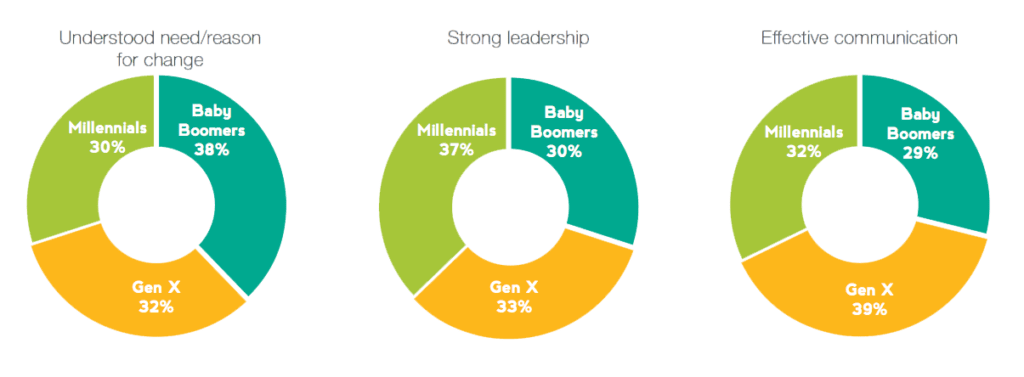Report
Across generations. Change is change. People are people.
Change management for multigenerational workforces

A recent Eagle Hill survey of more than 1,000 working professionals reveals that employees of every generation need two behaviors from managers to successfully adopt change—strong leadership and effective communication. Managers that ground their approaches to managing organizational change, both big and small, in these actions are most likely to succeed.
Effective change management is about people. When change is successfully managed, an organization’s employees are motivated and inspired to support, adopt, and maintain the desired change, all while continuing normal, everyday operations. This isn’t easy.
Leading staff through periods of organizational change is often one of the most daunting workplace challenges that managers encounter. Whether addressing a substantial reorganization or a small policy adjustment, managers are sure to confront resistant employees. And with more multigenerational workforces than ever, managers need the right approach to marshal diverse groups of employees through workplace changes.
Change management in a multigenerational workforce
Not surprisingly, there is an abundance of academic and professional research discussing how to lead workforces through change. Recent discourse has focused on multigenerational workforces—different age groups’ tendencies and how to effectively engage employees of all generations in day-to-day business operations.
However, few studies explore the intersection of these two subjects, and the change management preferences of employees of different age groups. This has left a critical question unanswered. Does generation matter when it comes to managing organizational change? In July 2014, Eagle Hill polled more than 1,000 employees to find out. The national survey included professionals across multiple industries, levels of responsibility, and age groups. The poll asked respondents to consider a recent change in their workplace, how the change was managed, and their overall satisfaction with the change. The survey was conducted online by SurveyMonkey.
Crossing generational divides
With few exceptions, our survey underscored that generational preferences for change management align. Respondents said that strong leadership, effective communication, and understanding the need or reason for change—in essence, a combination of change leadership and communication—were the most important factors to successfully adopt a change. What’s more, Millennials, Generation Xers, and Baby Boomers were split almost equally in their preference for these three factors.
In simple terms, managers facing complex change initiatives can be most successful if they focus on:
- Exhibiting strong leadership
- Practicing effective communication
- Understanding how leadership and communication during change are different than day-to-day approaches
Change leadership vs. everyday leadership
According to our survey, strong leadership was the single most important factor contributing to successful change in an organization.
Respondents from each generational group identified failure to exhibit strong leadership as the number one reason for failed change initiatives. What’s more, the majority (89%) of happier employees post-change attributed success to strong, visible leadership.
Change leadership differs from “everyday” leadership. Effective change leaders must build a compelling case for change and vision for the outcome of the change to generate and sustain organization- wide support.
Convincing employees of the need for change is half the battle. Leaders must visibly support the case themselves. Celebrating short term wins, promoting and using feedback, and participating in promotional events supporting the change all help motivate employees around the change vision. The importance of leading by example cannot be overstated. Consider that of the employees surveyed who were happier after a change, 94% said their manager was a role model during the change. Just 50% of employees who were less happy after a change saw their manager as a role model.
Change communication vs. everyday communication
While all managers should be able to communicate effectively on a day-to-day basis, it takes a strong leader to communicate effectively during a period of change.
Survey respondents identified poor communication of the rationale for change and poor overall communication as top reasons that organizational changes fail. Successful change communication addresses these two shortfalls by focusing on achieving two primary objectives:
- Successfully building the case for change
- Alleviating uncertainty amongst employees during change initiatives
Generational stereotypes abound when discussing preferred methods of change communications. Millennials’ love of technology and Baby Boomers’ preference for face-to-face meetings are two common characterizations. However, our survey suggests that these stereotypes are largely misguided.
Millennials, Generation Xers, and Baby Boomers responded similarly when asked their preferred medium for receiving information during change. In descending order: team meetings, one-on-one meetings, e-mails, group trainings, and company-wide meetings were each group’s preferred communication medium. Most respondents—regardless of generation—preferred forms of in-person communication over e-mail 4 to 5. When asked if they actually received the communication methods they preferred, respondents of all three generations said they experienced far more e-mails and far too few one-on-one and team meetings.

How to successfully lead and communicate change
Change is unavoidable. Public and private organizations must change to keep pace with new and emerging technologies, public and consumer preferences, and shifting personnel demographics.
For managers leading organizational change, building and maintaining staff support is nonnegotiable for success. Managers should put generational stereotypes aside and focus on providing strong leadership and effective communication—from change initiation to completion. Key actions include:
- Build a strong case for change
- Seek regular feedback from staff
- Provide visible leadership help to motivate and engage employees
- Develop the right messages and over-communicate them through multiple in-person and digital channels
Successful managers know their people, the nuances of how they accept or reject change, and what individual employees may need to hear. Adding to this insight and concentrating on leadership and communication makes all the difference in leading people of all ages through change.

Don’t rely on email to communicate change. Fewer than 1 in 5 surveyed say e-mail is their preferred method for receiving information during a change.
Managing millennials through change
As Baby Boomers and Generation Xers retire, Millennials will make up an ever-growing segment of the workforce. And while Millennial preferences largely mirror those of Boomers and Gen Xers, our survey uncovered tendencies for managers to consider when leading Millennials through change.
Making a strong case for change and driving momentum are particularly important for this group:

Communication
Most Millennial respondents (68%) were happier than any other generation (Gen X: 53%; Baby Boomers: 54%) about a change when they understood the case for change.

Momentum
Maintaining momentum through change is also key. In fact, 60% of Millennials who were unhappy after a change effort said they started off excited. Generating quick wins and maintaining regular communication can help engage Millennials over time.
EAGLE HILL NATIONAL WORKPLACE FEEDBACK SURVEY
Eagle Hill conducted a nationwide survey polling employed respondents about their experiences undergoing workplace change.
When
July 2014
Where
United States
Who
Sample of more than 1,000 currently employed professionals across multiple industries and generations, including Millennials (238), Generation X (395) and Baby Boomers (443).

